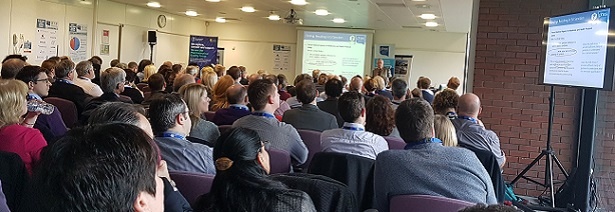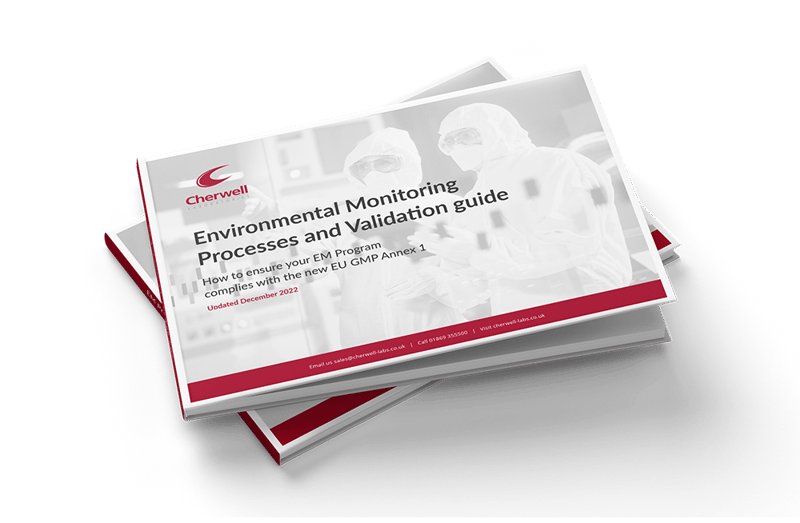
Following the release of the draft copy of EU GMP Annex 1 for public consultation, PHSS jointly with PQG (Pharmaceutical Quality Group) organised a conference for its members to question one of the authors of annex 1, and to openly discuss the annex 1 along with the response that PHSS and PQG will be sending to the EMA. Sales Manager, Andrew Barrow and myself were delighted to represent Cherwell Laboratories at our stand. It would be fair to say PHSS initially underestimated the level of interest in the Annex 1 update. When the meeting was first announced they were expecting around 40 to 50 delegates. A few days before the conference, the delegate list had 157 names, plus the exhibitors and speakers. We think there were nearly 200 people in the room when the conference started at 10am that day! It would not be an exaggeration to say, almost every single major manufacturer of sterile products in the UK had a representative there.
Key note presentation: Regulatory perspective on EU GMP Annex 1 consultation document
The opening presentation was from Andrew Hopkins of the MHRA, head of the EU GMP Annex 1 EMA/PICS/WHO revision working group. The first point to make is this update is not just to EU GMP, this will affect PIC/S guidance for the countries whose inspectors are members, and for countries who use WHO guidance for the manufacture of steriles. Essentially this affects most countries that have sterile manufacturing.
Hopkins began by giving a brief history of the update. A significant update was first recommended by the German regulators back in 2012. As they claimed they did not have the resources to begin the process nothing was done until 2014 when the MHRA recommended the same thing. The working group was setup in September 2014, with 16 members from all over the world, including 2 from the US FDA. As an international document and bearing in mind the FDA already has detailed guidance, it was important to get their input.
To summarise the significant new content in Annex 1, the most noticeable was the inclusion of the principals of Quality Risk Management (QRM). As both the WHO and PIC/S were involved in drafting the new Annex 1 this was a truly international document. Countries that do not have their own regulatory authority will use WHO guidelines in manufacturing steriles. There was also a recognition that it could not be a step change in stringency. Had there been a requirement to work to the latest technologies, for example the compulsory use of isolators or RABS, you would immediately close half the world’s steriles manufacturers. There is already a worldwide drug shortage, clearly a bigger shortage would be unacceptable!
Pharma industry perspective on EU GMP Annex 1 consultation document
Ian Symonds, from GSK, followed Hopkins to summarise the comments that PHSS received from industry feedback. Before the meeting PHSS had received 1226 comments from its members. PHSS were pleased that most of the comments received were constructive with a considered debate to explain the perspective of those comments.
PHSS members welcomed the inclusion of QRM although some of this is contradicted by text that is too prescriptive. A question asked was “does the draft provide clarity and unambiguity”, the general thought was that it did not in all areas. This was an opportunity to achieve greater clarity. Bearing in mind this document will be translated into multiple languages, the use of certain words requires consideration. One delegate pointed out the use of the work “should”. This is used 602 times. “Should”, translated into other languages is not a strong enough word.
PHSS-PQG Comments to be submitted to the EMA
The PHSS response to the EMA is going to be based on the common themes taken from all the comments received. PHSS Chair, James Drinkwater, explained how the PHSS were going to respond. They were taking perspectives from two groups of members. One was from the perspective of the global pharma members - they include the likes of GSK; Pfizer; Johnson & Johnson; Eli Lilley; Merck; AstraZeneca; Novartis etc. The other group of members were equipment manufacturers, which included F.Ziel; Bausch & Strobel; TSI; Pharmagraph; Du Point etc, and also the response from academics.
The PHSS listed the issues that is causing them cause for concern. This included a concern that much of the increased content was suggested by the Asian PIC/S members to meet their unique requirements. Also, PHSS are concerned some industries require more guidance to achieve GMP, a lack of inference to barrier designs and technologies. There were also concerns about the inclusion of PUPSIT (Pre-Use Post Sterilisation Integrity Test of Sterilising Filters).
Discussions on key concerns and comments on Annex 1 revision
The post lunch sessions gave the members the chance to debate 14 points that the PHSS and PQG committees thought were worthy of further consideration. Of interest to us at Cherwell Laboratories were the points of discussion associated with environmental monitoring. Andrew Hopkins was due to leave early so anything that was microbiology related was discussed before he departed.
Viable Monitoring during critical operations was a well discussed point. One delegate wanted more clarity on what a critical operation is. Hopkins responded that this should be decided as part of quality risk management. The methods for continuous monitoring were mentioned. Settle Plates are currently the accepted method to achieve this, however there is provision in the new annex 1 to consider newer or alternative technologies to achieve the same goal, provided the method is scientifically proven to be at least equal to the current methods used.
Another area where QRM needs to play a factor is deciding the appropriate background environment to a grade A area. For isolators, grade C is the recommended environment for isolators where aseptic filling is performed in FDA guidance, grade D is recommended in annex 1. This is an example of annex 1 being an international document, allowing more leeway than other local guidance documents.
Other topics discussed included the scope and glossary – the glossary was directly copied over from the FDA guidance. Also discussed included sterile product manufacturing via terminal sterilisation or aseptic processing; changing practices including the use of goggles, gloves and socks; cleanroom qualification and classification; environmental monitoring data review and VHP application in GMP environments.
After much furious taking of notes the conference ended, PHSS and PQG had plenty of comments to take away for consideration when writing their response to the EMA. It was noted that at the start of the meeting the response was already 50 pages long. Although Annex 1 is merely a “guidance” document, it is ultimately enforceable by law, with some countries writing it into their local laws. The need to get it right is clear, hopefully the PHSS comments will point the EMA in the right direction.
As the PHSS promised, they have submitted two responses based on the comments from the two groups that were mentioned earlier. Click on the following links to view their response for each group. Group one - pharmaceutical industry and GMP consultants. Group two - pharmaceutical equipment manufacturers, suppliers, consultants and supporting academics.
Since the conference, a closely affiliated organisation, the PDA, have submitted their recommendations. If you are interested, click here to read it.
Another outcome of the meeting, was to realise that there is still a long way to go before the final version of annex 1 is published. Partly due to the EMA relocating from London to Amsterdam, as part of Brexit over the next few months. We have been told that this will affect certain operations within the agency. We will endeavour to keep you up to date with the latest developments.
You can subscribe to our blog below (we only send out a maximum of one email a week with our blog topics). You can also sign up to receive our bi-monthly newsletter by clicking on the sign up button below to make sure that you don't miss out on any further updates we publish on the revision of annex 1.








